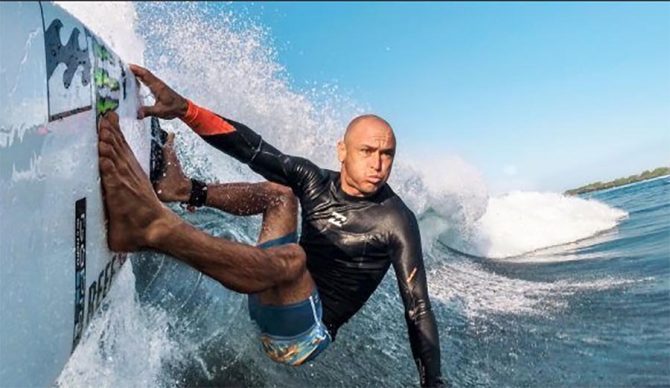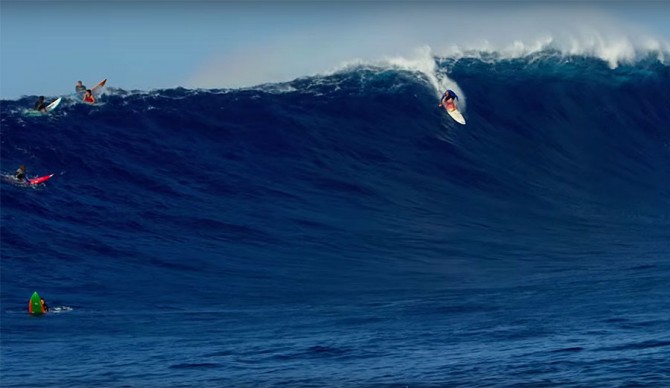
Shane Dorian has put a lot of stress on that body.
In early October, many of the almost half-a-million followers of Big Island surf star Shane Dorian’s Instagram posts were surprised to see, in contrast to the many images and stories depicting a seemingly charmed life (beautiful family, exotic travel, fantastic waves, healthy food, cool camo outfits and compound hunting bows), Dorian revealing that he was on his way to Tijuana, Baja Mexico, to undergo treatment at the Cellular Performance Institute, an exclusive facility specializing in stem cell therapy. More specifically, expanded hypoxic mesenchymal healing stem cells, essential components in one of the fastest growing areas of regenerative medicine, which, according to CPI’s website, are being used to treat, among numerous other ailments, “…orthopedic and sports-related injuries such as tendinopathy, damaged knees, shoulders and even herniated discs.”
It’s pretty easy to understand why Dorian might be choosing this innovative treatment option when one considers the inventory of impairment issues he’s apparently been dealing with for some years now: Shane reports that he had stem cells injected into both shoulders, both knees, his cervical and lumbar spine regions and right elbow. Ouch! Keep in mind, this isn’t your typical 51-year-old male we’re talking about, nor a typical, just-past-middle-aged surfer. Shane Dorian is an elite, finely turned athlete, who since his teens has been considered one of the best surfers in the world, in waves from two feet to 60.
Determinedly healthy, incredibly fit, he took up rigorous CrossFit training over a decade ago, even winning some regional competitions, and would think nothing of a solo, three-day, backcountry elk hunt, carrying out 100 pounds of elk burgers on his back. Shane has presented himself as this indomitable figure of protracted youth and vigor. Yet if his trip across the border tells us anything, it’s that a life such as Shane’s comes at a price. And it’s a steep one.
Dr. Warren Kramer is a renowned orthopedic specialist and accomplished, lifelong surfer (a Lower Trestles regular) who has diagnosed and performed corrective surgeries on literally hundreds of fellow surfers, including an impressive number of the sport’s biggest names. If anyone can give us a clearer picture of how surfers like Shane, and, in fact, the rest of us, are paying for our passion, it’s this very tuned-in M.D. [Disclaimer: Warren has also had me on his table for both shoulder and knee operations.]
Neck
“Throughout their life a regular person, if examined, might show evidence of cervical arthritis at about 0.5 percent. On the other hand, the victim of a single car accident in which the head is snapped back against the headrest, experiencing what we call whiplash, would see the incident of cervical arthritis go up to 23 percent—fifty times higher. That’s after a single accident. Now just imagine how often a surfer’s neck is snapped back during a wipeout in the size of waves that someone like Shane Dorian rides at Peahi, where it’s impossible to control the angle of the head. We’re talking multiple incidents of whiplash during every big wave season. And that’s not even taking into account the years, sometimes decades, of prone paddling with our heads arched back. Of all the surfers over the age of 50 that I’ve examined, not one had a cervical spine that didn’t show damage. This includes many of the big names from the ’70s and ’80s, too, not all of them big wave surfers. I’ve had them all in my office at one time or another, often complaining about shoulder pain, when the problem really was in their neck. There’s just no avoiding it.”
Shoulders
“Throwing spears might be one thing, but other than that our shoulders just aren’t meant for a lot of overhead work. Which is why, for example, they say that anybody who pitches in the Little League World Series will never pitch in a Major League World Series. And paddling is like throwing a baseball over and over again. Not just the pros, but if you take any random sample of longtime surfers, 100 percent of them will show some sort of rotator cuff damage. Then throw in bad mechanics and you really get into trouble. The shoulder is a ball-and-socket joint, but with bad scapular mechanics, in a surfer’s case not lifting the elbow and sweeping the hand below the rail of the board when paddling, it becomes a hinged joint. Just grinding the rotator cuff over and over with every stroke. Even on land, proper shoulder mechanics, meaning not slumping over, but rolling your shoulders back, goes a long way to minimizing rotator cuff damage, but unfortunately some level of damage is inevitable.”

Shane Dorian, during the 2015-2016 El Nino winter.
Lumbar
“Think about all the time you spend sitting on your board, rocking back and forth, up and down, settling in. Then suddenly a wave comes and you shift to your belly and start paddling. You’ve just put your lumbar spine’s facet joints under a lot of stress, just grinding them over and over. That’s why most older surfers exhibit some level of what’s called facet hypertrophy, which is when the facet joint enlarges, usually with bone spurs or new bone growth, in the body’s attempt to repair the damage all that grinding does to the cartilage. This narrows the spinal canal, compressing the nerves and causing pain, especially running down the leg in what is called sciatica. Arching your back properly when paddling helps here, but let’s face it, very few 50-plus surfers are arching their backs like 20-somethings.”
Hips
“Hips are so important to good surfing. But look at how many surfers, even surfers like Kelly, are dealing with torn labrums – the labrum being the ring of cartilage that lines the rim of the hip joint. A ball-and-socket joint, the hip allows movement in three major axes: forward and back, in and out, and external and internal rotation. But sitting on your board all those years, with your legs spread wide, puts a lot of torque on the joint, and you can end up grinding the ball against the hip socket, eventually tearing the labrum. This is especially common as a surfer ages, when they’re generally riding a wider board. Fact is, the hips just don’t want to go that wide for prolonged periods of time.”
Knees
“You can watch a group of surfers from 100 yards away and know how old they are by just looking at how they flex their knees. Most surfers in their 50s and 60s barely flex their knees at all, even though they think they might. That’s because throughout a lifetime the knees deal with an incredible amount of stress – just walking down a flight of stairs applies eight times your body weight onto your knees. So again, just imagine how much a lifetime of surfing affects your knees. Not even taking traumatic injury into consideration, with continual flexing over the years, a movement that really is what surfing is, the kneecap cartilage begins to break down and the knee starts to hurt. The whole knee weakens and that’s when you commonly get meniscus cartilage damage. Not from any particular injury, but simply from continual use. Half of all the surfers over 50 who I’ve worked on had no idea how they tore their meniscus. So at a really high surfing level, you can see how easy it is to tear knee cartilage.”
Well, easier now, thanks to Dr. Kramer. Just as easy it is to see that the price Shane Dorian has paid to line up right alongside others who may pull into six-story Peahi barrels or suffer two-wave hold downs at Maverick’s, is eventually going to be exacted from all those everyday surfers who plan on someday joining the Social Security Surf Team.

